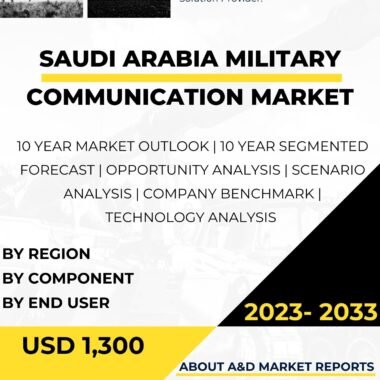Description
Tactical Video Data Link market in the United Kingdom is a critical component of the broader defense communication landscape, focusing on secure, real-time transmission of high-definition video and sensor data among diverse military platforms. These video data links form the communication backbone that supports joint operations across air, land, and naval forces, enabling commanders and operational units to maintain situational awareness and coordinate effectively in complex mission environments. The UK?s tactical video data link market growth is influenced by modernization efforts within the Ministry of Defence, coupled with the country’s participation in NATO and multinational operations, thereby emphasizing interoperable and secure communication frameworks. There is a particular focus on evolving legacy systems such as Link 16, which is integral for secure data exchange across fighter aircraft, naval ships, and ground units, and on integrating these data links into cutting-edge platforms like the Type 26 frigates and the upcoming Tempest fighter program.
The tactical video data link systems enable the transmission of real-time imagery and tactical intelligence which is crucial for mission success, particularly in contested or electronically congested environments where delayed or compromised communication can have serious consequences. In the UK, these systems help reduce the risk of friendly fire incidents and enhance operational agility by allowing seamless sharing of visual data and command instructions across deployed forces. The integration of such systems supports network-centric warfare doctrines, where forces operate as interconnected nodes, sharing timely information to optimize battlefield decisions and multi-domain operations that combine air, sea, and land assets.
A significant driver in the UK market is the evolving threat landscape that demands enhanced cybersecurity measures and resilient communication channels to counter electronic warfare and signal jamming attempts. The UK defense sector invests heavily in upgrading video data link capabilities with advanced encryption, low-latency transmission, and robustness against cyber threats. These technical enhancements ensure video feeds remain secure and uninterrupted, allowing commanders to maintain a clear operational picture and respond swiftly to emerging threats. The focus extends beyond battlespace visual data to encompass integration with sensor fusion and real-time analytics, thus amplifying the value of video data links as part of a broader intelligence network.
The UK market also derives momentum from increasing procurement of unmanned aerial vehicles (UAVs) and other autonomous platforms that rely heavily on tactical video data links for reconnaissance, surveillance, and target acquisition missions. These unmanned systems, connected via secure video data links, extend the reach of human operators into contested zones, providing persistent situational awareness while reducing risk to personnel. The ability to stream live video from UAVs to command centers and frontline troops enhances operational coordination and mission effectiveness. The market growth is supported by both domestic defense manufacturers and international defense contractors supplying interoperable systems compatible with UK and allied forces standards.
Moreover, investments in naval capabilities, especially in the Royal Navy?s modernization programs, drive demand for tactical video data link systems designed to operate over long distances and in challenging maritime environments. Ships such as the Type 31 and Type 26 frigates incorporate these links for enhanced naval situational awareness and coordinated operations with airborne and land-based units. There is also an emphasis on ensuring tactical video data links can function reliably across joint operations with NATO allies, necessitating adherence to common standards and protocols.
The UK?s commitment to maintaining a credible and modern defense posture contributes to a steady rise in tactical video data link adoption, with budget allocations reflecting priorities in command, control, communications, computers, intelligence, surveillance, and reconnaissance (C4ISR) capabilities. Government and defense stakeholders recognize that robust, real-time video communication enables rapid decision-making and improved battlefield outcomes, key factors for success in contemporary military engagements. The tactical video data link market in the UK is thus characterized by strategic modernization, technological innovation, and growing demand from emerging multi-domain operational concepts.
Leading defense companies in the UK, including BAE Systems, play a vital role in developing and integrating tactical video data link systems. These firms collaborate on research and development initiatives focusing on enhancements in bandwidth efficiency, encryption protocols, and system miniaturization to meet the evolving operational needs of British Armed Forces. The market also benefits from multinational partnerships and technology exchange programs within NATO, aligning the UK?s video data link capabilities with allied forces? evolving requirements for joint interoperability and rapid information sharing.
In summary, the tactical video data link market in the United Kingdom is a dynamic space marked by ongoing military modernization programs, advancements in secure and real-time video communication technologies, and the strategic imperative to support integrated multi-domain operations. The market is driven by the need for enhanced situational awareness, real-time decision support, and secure communication across air, land, and maritime platforms. As the UK continues to upgrade its defense systems to meet new operational challenges and maintain alliance interoperability, the tactical video data link infrastructure remains central to achieving superior command and control capabilities and mission success in complex, fast-evolving conflict scenarios.




